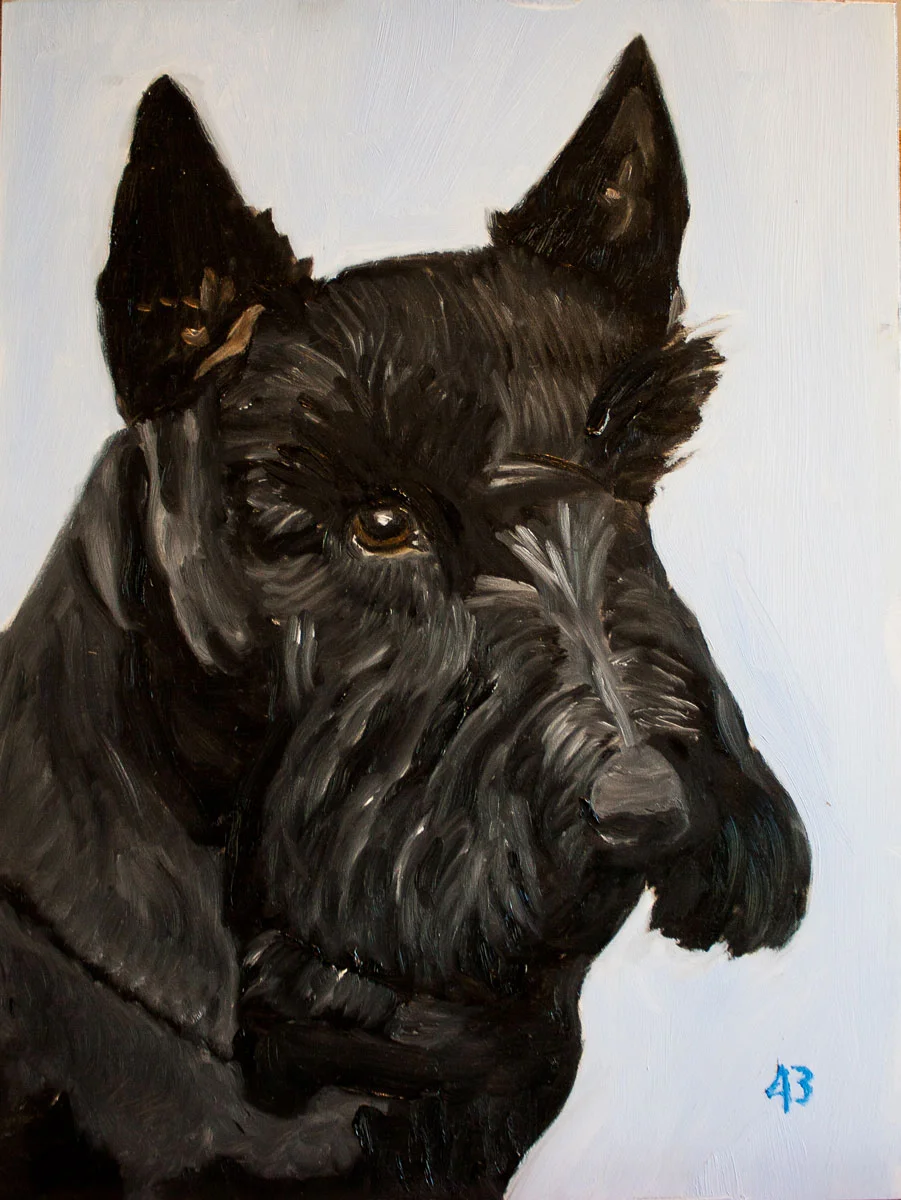
George W. Bush, “Barney,” (2013). Oil on gesso board. Courtesy The Bush Family.
[](#)[](#)
Column: Politics
I Used To Head Up Wars, Now I Draw Cats
Thanks to hacker Guccifer, who’s leaked pictures of paintings by George W. Bush to Gawker all year, anyone with Internet access can tap into the inner thoughts of the 43rd U.S. president (which are largely, as it turns out, consumed with dogs and cats). Among the 90 or so works from the former president are two Lynchian self-portraits: One of W. in the bathtub, two bowed legs poking out of murky water; the other of W. in the shower, his beady eyes staring at the viewer from a reflection in the showerhead. In both cases, the portraits, in subject matter and execution, are so mundane they’re almost suffocating in their portrayal of the tediousness of everyday living. They seem to reflect, ironically, on both the experience of the retiree and the young professional working in fluctuant job markets. See them and consider this question: What does a man with nothing to do, do?
Ol’ G. Dubbya is not alone. Other American presidents have toiled away their post-White House time with artistic endeavors. Start with Ulysses S. Grant, perhaps the most well-known case. Cash-strapped and dying of cancer, Grant began work on his Personal Memoirs to make a little money for his family. Mark Twain published the book, which became a huge critical and financial success.
While a cadet at West Point, Grant studied art under Robert Walter Weir, along with James McNeill Whistler, whose painting “Whistler’s Mother” adorns the walls at the Musée D’orsay in Paris. Grant was modest about his artistic ability, not mentioning it at all in his Memoirs, but was nonetheless a skilled young artist. Grant loved horses. By the age of nine he was able to buy a horse of his own with money he had made shuttling people by horse drawn cart from Georgetown, Ohio to surrounding towns. One of the few works by Grant that has survived is a sketch he did of a horse pulling a cart, its snout in a feedbag.
Though he did this piece when he was young, the image of the tired and oppressed horse seems to be an apt representation of Grant in his later years. For a man who would become a war hero and a two-term president, Grant was, for a good portion of his life, a failure, and a sad sack. He was prone to bouts of extreme loneliness and depression, as well as what he and those closest to him called “sprees” of alcoholism. By the time Grant was 38 years old, he was unemployed and broke, and had to ask for a job at his father’s tannery. If not for the outbreak of the Civil War, history may have never heard of Grant, as he was content to work for his father, providing for his wife and two sons.
An artist/president with a little more confidence was Herbert Hoover. He’s remembered as a stiff and a dud president; on the contrary, he was something like the Dos Equis man. Before moving to the White House, he had made millions as an engineer for the mining industry, survived the Boxer Rebellion in China, led humanitarian efforts in Europe to feed the starving during WWI, and even translated an ancient German book on metallurgy, De Re Metallica by Georgius Agricola, with his wife Lou Henry.
In the White House, Hoover wasn’t an artist, but an expert doodler, as Cabinet Magazine and David Greenberg revealed in their book Presidential Doodles: Two Centuries Of Scribbles, Scratches, Squiggles & Scrawls From The Oval Office. Hoover scribbled intricate designs made of circles and triangles that look like machines from a sci-fi movie. When Hoover was elected president he was one of the most popular private citizens in America, so when his futurist doodle leaked, a design firm used it as a pattern for a line of baby clothes called, “Hoover Scribble Rompers.”
Dwight Eisenhower—a more beloved president than Hoover, and the only president of the 20th century to govern over eight straight years of total peace—picked up painting after WWII, while he was President of Columbia University, on the advice of Winston Churchill. But Eisenhower never took his art seriously, and even burned a few of his finished canvases.
Most of his paintings are attempts to perfectly reproduce things he saw, like an oil painting from 1955 called White Birches that shows simply and skillfully, a birch tree in the foreground surrounded by thick white snow, with three red barns in the background. Ike would also do recreations. In fact, that is how he learned to paint. He copied, as best he could, his friend and painter Thomas Stephen’s portrait of Ike’s wife Mamie. Looking at Eisenhower’s paintings, their subdued simplicity, it is funny to think that they came from the same brain that engineered the allied invasion of Europe that won WWII.
But that is true of all these pieces of artwork. The honesty of the work, the act of pure expression, rarely matches up with the polished figures these men were when in office. Maybe it’s through artwork that we feel we can access the true nature of the person behind the politician, get a sense of truth in an arena that relies—and thrives—on the perfection of a façade.
